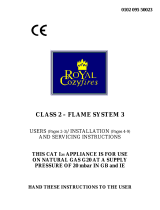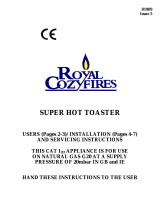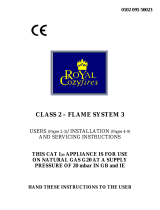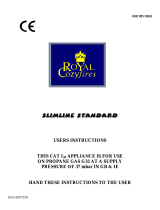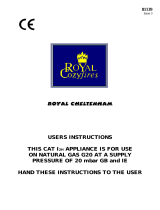Page is loading ...

0102 095 50034
CLASS 1 – FLAME SYSTEM 2
USERS (Pages 2-3)/ INSTALLATION (Pages 4-8)
AND SERVICING INSTRUCTIONS
THIS CAT I
2H
APPLIANCE IS FOR USE
ON NATURAL GAS G20 AT A SUPPLY
PRESSURE OF 20mbar IN GB and IE
HAND THESE INSTRUCTIONS TO THE USER

86(56,16758&7,216
'(6&5,37,21
The Flame System 2 has a single aerated burner, the design of which produces a ribbon of flame which runs across the front
of the fire bed. A single gas control combined with piezo igniter selects ignition (pilot only) and can be turned anticlockwise
to select a high rate and then a reduced input at the maximum rotation. For extra safety the control is designed so that gas
cannot be allowed to reach the burner until pilot ignition has been proven.
A Flame Supervision Device (FSD) is fitted. This ensures that if the pilot goes out for any reason (including being turned
off), the gas flow to the burner is cut off until the full lighting procedure is repeated. The oxy-pilot or O.D.S. will cause the
appliance to ‘shut off’ in the event of continued spillage occurring under hazardous or blocked flue conditions. The burner
assembly is fixed to the base of the radiant box which also includes a fire back made of ceramic fibre, this forms an
insulating surface to reflect heat into the fire bed, raising its temperature and increasing the amount of heat radiated into the
room. A decorative trim completes the front face of the appliance.
There are various types of front and fret available for this appliance; these have perforated frets to allow air to be entrained
into the fire bed to ensure clean combustion. The optional fire fronts and frets are listed with your supplier. If other Fronts
and Frets are to be used they must have a minimum open area in the fret of 20 square centimetres and 60 square centimetres
in the Front, as shown in figure 11.
,03257$17127(6
The Flame System 2 is a decorative fuel effect appliance designed and manufactured to the requirements of the British
Standards Institution BS 5258 Part 12: 1990 and EN509. It is for use on Natural Gas only
.
All gas appliance installations must be installed by a competent person in accordance with the current Gas Safety
(Installation and Use) Regulations or the rules in force and in accordance with the attached Installation Instructions;
failure to do so could lead to prosecution.
The appliance is fitted with an ODS, a spillage monitoring system which operates if the evacuation of products is
interrupted (i.e. blocked or incorrect flueing). If the gas fire repeatedly ‘goes out’ it may indicate a problem and the
installer or specialist should be informed before further use.
Areas of this appliance will become hot after prolonged running and it is recommended that for the protection of the very
young, elderly and infirm a fireguard conforming to BS 6539 or BS 6778 be used.
Care should be taken to prevent any damage being caused to surrounding soft furnishings or decor e.g. many embossed vinyl
wall coverings may become discoloured if located too close to the appliance. Clearances required for combustible shelves
are shown on page 3.
This product uses fuel effect pieces, gaskets and insulation material containing Refractory Ceramic Fibre (RCF), which
are man-made vitreous silicate fibres. Excessive exposure to these materials may cause temporary irritation to eyes, skin
and respiratory tract, consequently, it makes sense to take care when handling these articles to ensure that the release of
dust is kept to a minimum.
It is recommended that the chimney or flue should be swept annually by a competent person and the appliance checked for
spillage (smoke test) and that there are no excessive deposits of soot.
The curing effect of heating the coals will cause an initial odour which, although not harmful, may require additional
ventilation until the odour has disappeared. This appliance will run on Full for approximately 4.4 hours on one therm of
gas.
72/,*+77+($33/,$1&(
1.
Remove the fret (controls cover), to gain access to the controls
2.
Press and turn the gas control anti-clockwise, keep the control fully depressed. The igniter will operate and the pilot will
light, if not repeat the operation.
3.
0nce a pilot-flame has been established; keep the control depressed for a further 20 seconds. Release the gas control and
check that the pilot remains lit.
4.
Depress the gas control slightly and turn anti-clockwise until the indicator mark is aligned with the letters HIGH. The
burner will cross light from the pilot.
Page 2

5.
Depress the gas control slightly and turn anti-clockwise until the indictor mark is aligned with the letters LOW. The
burner will now be at minimum rate.
6.
To turn the appliance ‘off’, return the control to the ‘OFF’ position.
7.
If for any reason the fire cuts out, return the control knob to the `OFF’ position and wait 3 minutes before re-
lighting.
8.
In the event of failure of the igniter the fire may be lit by placing a lighted taper or match at the pilot position at the
same time depressing the gas control in the IGN position.
5(029$/2)'(%5,6RU6227'(326,7
Debris from any source or any soot formed shall require removal. Allow the appliance to cool for two to three hours
before removing all of the coals and ceramic blocks for cleaning purposes. Once all the ceramics are removed from the
fire bed check that no debris is located in the burner slots. If any debris is present it may easily be removed by using a
small piece of thin cardboard to ease out any foreign matter. Be sure to remove the cardboard after use. Cleaning should
be carried out in a well-ventilated area or in the open air, by gently brushing with the pieces held away from your face so
that you avoid inhaling the dust. We do not recommend the use of a normal domestic vacuum cleaner, which may blow
dust back into the air.
6(77,1*837+(&2$/%('
(See the identification sheet figure 13)
Components
Coal support shelf. 10 Large Coals..
Artificial coal front. 15 Small Coals
The coal support shelf is positioned on the fibre support metalwork, ensure that the shelf sits against the two stops which are
to prevent the shelf sitting on the burner outlet. Place the simulated coal front in position as shown in Fig.6, three tabs are
provided to locate. The one-piece coal support shelf is constructed to allow three levels of coal support; these three levels are
shown in Fig 6, the plan view of the bed.
&2$//$<287
First Layer. Position 3 large and 6 small coals across the gap between the front simulated coal and the lower level of the
coal support shelf.
Position 4 large and 3 small coals on the middle level of the coal support shelf.
Position 3 large coals on the upper level of the coal support shelf. See figure 7.
Second Layer. Position 6 small coals to fill the gaps between the coals on the lower level and middle level of the coal
support shelf. See figure 8.
To obtain the best visual appearance it may be necessary to make slight adjustments to the position of the coals.
NOTE: Additional coals must not be used. If any of the coals or the coal bed becomes damaged, lost or broken,
genuine manufacturer’s replacements must be obtained (part numbers listed in short spares list) before the appliance is
used.
9(17,/$7,21
Purpose built ventilation is not required for this appliance in GB only. For Ireland (IE) ventilation is required with a
minimal cross sectional area of 100 sq. cms and should be checked regularly to ensure that it is free from obstruction. It
must be fitted in accordance with the rules in force.
&/($5$1&(726+(/9(6
Minimum clearances to underside of a 150mm (6ins) combustible shelf from the top of the fire opening must be 228mm
(9ins). Add 12.5mm (1/2in) to this clearance for every 25mm (1in) increased depth of shelf.
&/($5$1&(726,'(6
Minimum Clearance required to any combustible material to the side of the appliance must be 150mm (6in)
The list of coal part numbers that the user can replace is at the back of this document.
This appliance is intended for decorative purposes.
Page 3

INSTALLATION INSTRUCTIONS
,167$//$7,215(48,5(0(176$1'5(*8/$7,216
The appliance must be installed by a competent person in accordance with the current Gas Safety (Installation and Use)
Regulations or the rules in force and in accordance with the manufacturer’s instructions. Failure to do so could lead to
prosecution.
The following are the relevant Codes of Practice and British Standards.
The Building Regulations issued by the Department of the Environment.
The Building Standards (Scotland)(Consolidation) Regulations issued by the Scottish Development Department.
BS 8303 1994 BS 5440 Pt1 1990 & Pt2 1989 BS 7566 Pts 1-4 1992
BS 1251 1987 BS 5871 Pt3 1991
BS 6891 1988 BS 6461 Pt1 1984
Important Notes
The fire place, chimney or flue must be sound and conform to the requirements of BS 83O3 1994 & BS 6461 Part 1 1984.
The effective flue height must be a minimum of 3 metres and should be a 225mm x 225mm brick, stone or a lined flue with
a minimum diameter of 175mm. Any permanent flue restrictions must be removed, and any variable dampers locked fully
open or removed. The flue must be swept prior to installation, unless new.
Care should be taken to prevent any damage being caused to surrounding soft furnishings or decor e.g. many embossed vinyl
wall coverings may become discoloured if located too close to the appliance. Clearances required for combustible shelves
are shown on page 4.
A hearth must always be provided to project forward of the trim a minimum of 300mm and a minimum of 150mm either
side of the fire opening. The hearth must be a minimum thickness of 12mm with a perimeter height of 50mm to deter
combustible materials, carpets etc, being placed on the hearth. The area under the firebox must have a minimum
non-combustible thickness of 25mm. In most installations a back panel will be required, this will need a minimum fire
resistance rating of Class O (100
O
C).
7(&+1, &$/'$ 7$
Height 560mm overall size of Box
Width 410mm overall size of Box
Depth 265mm overall size of Box
Height of Trim 605mm
Width of Trim 505mm
Overall Depth inc Front & Fret using (MACH 11) 340m
Maximum heat input (HIGH) (GROSS) 6.95 kW, 23,700 Btu/h
Minimum heat input (LOW) (GROSS) 3.6 kW, 12,300 Btu/h
Supply pressure (cold) 20 mbar +/- 1 mbar
Injector marking Cat. 046/19/196/79M
Pilot OP Oxy/Pilot NG 9022
Gas valve Concentric TESA 3058/S
Gas Connection 8mm O/D Tube
&217(176&+(&./,67
(See pages 14 & 15 for identification)
VENT BOX ASSEMBLY C/W: Burner assembly, and trim.
1 Simulated coal front
Coal support shelf
10 Large and 15 Small Coals.
Fitting kit
Installation & Users Instructions.

Page 4
,167$//,1*7+($33/,$1&(
If a fire back (chair brick) is fitted in the existing builders
opening (constructed of non-combustible material)
it will
be necessary to remove it together with any infill or rubble. Any remedial work should be carried out including
levelling the base beneath the fire. The sizes required for the opening are shown in Fig 2.
',60$17/,1*7+(),5(35,2572,167$//,1*
To prevent any damage and to assist with the installation of the appliance both the burner and the trim should be
removed. The trim is held in place by magnets. To remove the burner from the box unscrew the two screws at the
base of the fascia panel and lift the assembly approximately 200mm at the front to clear the fixing flange. When
refitting observe that the two feet at the rear of the assembly locate under the two lugs formed in the base of the
box assembly.
*$66833/<
BEFORE COMMENCING WORK, TURN OFF ANY APPLIANCES THAT ARE FED BY THE METER
AND ISOLATE THE SUPPLY BY TURNING OFF AT THE METER.
The gas connection to this appliance is made with 8mm O/D rigid or semi rigid tube to a combined pressure
test/restrictor elbow situated on the right-hand side of the burner as shown in Fig 1. Any pipe used under the tray
must be rigid tube such as bundy, a length is supplied for the convenience of the installer. Provision is made in the
rear of the box to make a concealed connection; (additional holes may be drilled as required). The installer is
reminded of the requirements of BS 6891 1988 dealing with enclosed pipes. The standard requires that when a gas
pipe is fed through a wall, the pipe should be enclosed in a tight sleeve to protect against failure caused by
movement and shall be constructed to prevent a passage of gas either between the pipe and sleeve or sleeve and the
wall. If a gas supply is required to be fed from either the left or right across the front of the appliance it should be
routed as shown in Fig 2. It is only the MACH II Front & Fret that has provision for this requirement alternative
Fronts & Frets will need modifying to allow access for the supply tube, see Fig 4.
),77,1*7+(9(17%2;
.
Position the box in the centre of the opening it is secured in place with the two 10x11/4 round headed screws and
plastic plugs supplied in the fitting kit using the two holes in the base of box. Replace the burner assembly in
position ensuring that the rear legs locate under the tags in the base plate and secure with the two screws provided.
Complete the gas connection to the burner as required and fit the trim (held in place by magnets), if the brass trim
is used remove the protective plastic coating before lighting fire.
72&+(&.7+($33/,$1&(6(77,1*35(6685(/($.7(67
A Pressure Test Point at the inlet elbow enables verification of the inlet pressure of the appliance under operating
conditions and can also be used to check the gas soundness of the connections to the appliance gas control. To
check the joints of the burner assembly for gas soundness it will be necessary to carry out the examination prior to
installing into the case. If a manometer is used care must be taken to ensure that it is not disconnected with the gas
turned on and the fuel bed hot.

Page 5
729(5,)<7+(,1/(735(6685(
The inlet pressure should be observed at 20mbar +/- 1mbar when the appliance is operating at its maximum rate. Any
significant reduction below an inlet pressure of 20mbar will indicate a restriction in the gas supply to the appliance that
should be identified and corrected. If there are any other appliances, which are relatively high rated (e.g., a central heating
boiler), fed from the same gas supply branch, it is advisable to perform this observation with both appliances in operation.
/2&$7,212)7+(),%5(%('
(See pages 14 & 15 for identification of components)
The coal support shelf is positioned on the fibre support metalwork, ensure that the shelf sits against the two stops which are
to prevent the shelf sitting on the burner outlet. Place the simulated coal front in the position shown in Fig 6, three tabs are
provided to locate. The one-piece support shelf is constructed to allow three levels of coal support; these three levels are
shown in Fig 6, the plan view of the bed.
&2$//$<287
First Layer. Position 3 large and 6 small coals across the gap between the front simulated coal and the lower level of the
coal support shelf.
Position 4 large and 3 small coals on the middle level of the coal support shelf.
Position 3 large coals on the upper level of the coal support shelf. See figure 7.
Second Layer. Position 6 small coals to fill the gaps between the coals on the lower level and middle level of the coal
support shelf. See figure 8.
To obtain the best visual appearance it may be necessary to make slight adjustments to the position of the coals.
NOTE: Additional coals must not be used. If any of the coals or the coal bed becomes damaged, lost or broken,
replacements must be obtained before the appliance is used
72/,*+77+($33/,$1&(
1.
Remove the fret (controls cover), to gain access to the controls.
2.
Press and turn the gas control anti-clockwise, keep the control fully depressed to purge the air from the pipework. Turn
‘OFF’ and repeat the operation, check that a spark occurs between the electrode and the head of the pilot. The pilot will
light, if not repeat the operation.
3.
0nce a pilot-flame has been established; keep the control depressed for a further 20 seconds. Release the gas control and
check that the pilot remains lit.
4.
Depress the gas control slightly and turn anti-clockwise until the indicator mark is aligned with the letters HIGH. The
burner will cross light from the pilot.
5.
Depress the gas control slightly and turn anti-clockwise until the indictor mark is aligned with the letters LOW The
burner will now be at minimum rate.
6.
Turn the gas control to the OFF position, wait for 3 minutes, fully depress the gas control, turn to IGN position and
release the control. Attempt to ignite the pilot with an already lighted match or taper. If the pilot ignites the FSD is
faulty.
7.
Re-light the appliance. With the control set to the maximum rate (large flame) position, place the Fire front & fret in
position and leave to heat up for 5 minutes. Check for satisfactory clearance of products by inserting a lighted smoke
match into the opening in the position shown in Fig 10, i.e. 100mm below the top, and 40mm inside of the front face of
the opening, all the smoke must be drawn into the flue. If spillage occurs, allow a further 10 minutes. Should spillage
still occur examine the chimney for the fault and rectify the cause. The test should be repeated if an extractor fan is
situated in the room, or in any connecting room, with all the doors in that room opened.
Demonstrate the lighting and extinguishing procedures to the user.

Page 6
$'9,6(7+$7
:
The curing effect of heating the coals will cause an initial odour, which although not harmful, may require additional
ventilation until the odour has disappeared.
Any debris or soot is cleaned from the appliance. Advise the customer that they should read their Users Instructions before
operating the fire and always follow the advice in the section headed ‘Removal of Debris or Soot Deposits’.
The appliance must be serviced annually by a competent person; i.e. a CORGI registered installer in accordance with these
instructions and that the appliance is checked for spillage in accordance with the method detailed in these instructions.
The appliance is fitted with an Oxy-pilot to prevent the continued operation in the event of spillage occurring. If the fire
shuts ‘OFF’ repeatedly the appliance must be turned off and not used until an expert is consulted. The Oxy-pilot must not
be adjusted or rendered inoperable and replacements must only be the manufacturers supplied part.
Complete the section in the enclosed registration leaflet. Advise that any component or part of this appliance is guaranteed
against defective workmanship or faulty materials for a period of twelve months from the date of purchase.
Any such part will be replaced free of charge on receipt of the purchasers address at the cost of postage only, provided
that:
a)
It is accompanied by the registration section cut out of the booklet together with the original purchase receipt, which
will be returned with the replacement part.
b)
A competent person has carried out installation repairs or adjustments, such as the supplier’s representative or a
CORGI registered installer.
0$,17(1$1&($1'6(59,&,1*
GENERAL
A.
REMOVAL OF DEBRIS OR SOOT DEPOSITS;
Allow the appliance to cool for one hour before removing all the coals and coal bed components for cleaning purposes. Once
all the components have been removed from the fire bed check that no debris has become lodged in the burner port. If any
debris is present it may be easily removed with a thin piece of card or similar to ease out any foreign matter. To ensure that
the release of fibres from these RCF articles is kept to a minimum, during installation and servicing we recommend that
you use a HEPA filtered vacuum to remove any dust and soot accumulated in and around the fire before and after
working on the fire. When replacing these articles we recommend that the replaced items are not broken up, but are
sealed within heavy duty polythene bags, clearly labelled as RCF waste. This is not classified as "hazardous waste" and
may be disposed of at a tipping site licensed for the disposal of industrial waste. Protective clothing is not required when
handling these articles, but we recommend you follow the normal hygiene rules of not smoking, eating or drinking in the
work area and always wash your hands before eating or drinking. Any soot deposits may be removed from either the
Thermocouple or Electrode tips with a soft cloth, do not use abrasive materials.
B. SERVICING COMPONENTS BELOW THE BURNER ASSEMBLY
Remove trim (held in place by magnets). Remove the coals, coal support and front simulated coal. To gain access to the
components below the burner assembly it has to be removed from the Vent Box by disconnecting the gas supply at the inlet
elbow and unscrewing the two screws at the base of the fascia panel. Lift the assembly approximately 20mm at the front to
clear the fixing flange. When refitting observe that the two feet at the rear of the assembly locate under the two lugs formed
in the base of the box assembly.
i) TO CLEAN OR REPLACE THE INJECTOR: Unscrew the compression nut connecting the gas supply to the injector
elbow while supporting the injector to prevent any distortion of the frame work. Unscrew and remove the gas supply tube
from the gas control valve, hold the injector lock nut with a spanner and rotate the injector. Replace in the reverse order.
ii) TO REPLACE THE GAS CONTROL / FSD: Disconnect the three gas pipes and the thermocouple from the control. .
Pull the control knob from the spindle; undo the two screws securing the control bracket to the main assembly. The tap
may now be withdrawn. Replace in the reverse order.

Page 7
iii) TO REPLACE THE OXY-PILOT ASSEMBLY: including electrode and thermocouple): THE PART MUST ONLY
BE THE MANUFACTURER’S SUPPLIED ITEM NO ADJUSTMENT OR ALTERATION MAY BE MADE OR THE
PILOT SYSTEM OVER-RIDDEN. The two securing screws are accessed through the front of the control panel. Undo
the pipe at the inlet of the pilot assembly and undo the thermocouple connection at the back of the tap. Withdraw the
pilot assembly. Clean off any lint or fluff taking care to avoid damage. The individual parts cannot be changed separately
as the assembly is precision built. Reassemble in reverse order. It is advisable to check joints for leaks prior to refitting
the burner unit into position. the spark gap is shown in figure 12.
FIRE FRONTS & FRETS SUITABLE FOR THIS APPLIANCE.
The supplier will demonstrate recommended Front and Frets, if an alternate Front and Fret is used, it is important
to maintain the equivalent ventilation to that shown.
63$5(6$1 ' 6(59 , &(
For spares and service, apply to your local Supplier, Installer or direct to the manufacturer, stating that the
appliance is a Flame System 2 quoting the Serial Number from the data badge located on the front controls panel.
Advantage should be taken of regular servicing and inspection for gas appliances to ensure their continued safe
operation.
6+2573$576/,67
DESCRIPTION PART No
Control Valve 0102 078 00031
Control Knob 40232
Oxy-Pilot Burner Assembly 0102 078 00061
Main Injector 0102 078 00011
Isolating Valve complete with PTP 0102 078 00041
Coal Support Shelf 0102 078 00451
Front Simulated Coal 0102 078 00271
Set of Coals 0102 092 40011
Maximum Heat Input (Gross)
6.95 kW 23700 Btu/h
Royal Cozyfires are manufactured by:
CROSSLEE plc
Aber Park Industrial Estate,
Aber Road, Flint, Flintshire. CH6 5EX
Spares Tel 01422 203963
Fax: 01422 204475
Service (GSA Ltd) 01703 516611
Customer Service 01422 200660
Fax 01422 206304

*Technical Help Line 0906 8633268
*Calls charged at 50p per minute
Page 8

Page 9
No fig 5 issued with this document

Page 10
Page 11

Page 12

Page 13

Page 14
/
